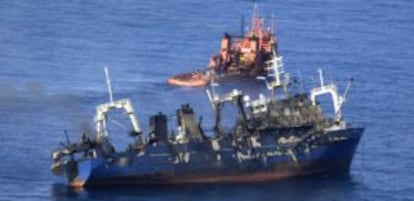Fuel still seeping out of trawler two weeks after it sank off Canaries coast
Prosecutors want to know why the Russian vessel was towed out to sea from port


Fifteen days after it sank off the Canary Islands, the fate of a Russian trawler is keeping residents of Gran Canaria, Tenerife and La Gomera on edge.
Oil slicks originating from the sunken ship have been reaching the coastline since then, raising fears of environmental damage despite the ongoing efforts of volunteer clean-up crews.
The fishing ship had 1,400 tons of fuel oil in its tanks when it caught fire inside Las Palmas’ port and a decision was made to tow it out to sea to avoid an explosion close to land.
Why was the ship not brought back to port when the fire was out and the risk of an explosion was over?
As it was being towed, the Oleg Naydenov sank 15 nautical miles (over 27 kilometers) south of Gran Canaria on the night of April 14.
The incident immediately triggered comparisons with the Prestige oil spill that devastated the coast of Galicia 13 years ago. But comparing both cases is an exaggeration, at least from the viewpoint of volume: the Prestige was carrying 77,000 tons of fuel oil; the Russian trawler had 1,400 tons in its tanks.
But both situations were handled in a similar way: in both cases, authorities decided to take the ships out to open sea rather than to a contained area near land where the spills would have been easier to handle.
Now, two weeks later, the government is at the mercy of complicated currents that could result in fuel washing up on popular beaches on the three islands.
Last week, a few stains were found in coves located on the western side of Gran Canaria, in the most environmentally valuable part of the island.
Prosecutors have launched an investigation into the case and asked for explanations regarding the government’s decision to tow the Oleg Naydenov out to sea.
The fire
The port of Las Palmas is Spain’s great marine gas station, pumping out around two million tons of fuel a year. The Oleg Naydenov arrived in March, and was scheduled to depart again on the night of April 11. The hold was full of fish.
But a fire broke out at 12.30pm that day. The president of the Port Authority, Luis Ibarra, said on Tuesday that the ship’s captain did not immediately inform them about the fire, causing “an important loss of time.”
Firefighters used water rather than foam to try to put out the blaze, a decision that caused the ship keel over.
Out to sea
The local maritime authority, which answers to the Public Works Ministry, took over the situation at 11pm and decided to tow the ship out to open sea. The trawler’s captain has told prosecutors that he considers this “a very serious mistake.”
Mario Rodríguez, head of Greenpeace Spain, agrees. “The port has a depth of 20 meters and it would have been easier to control the spill there and extract the remaining fuel,” he says.
But Environment Minister Isabel García Tejerina defended the decision in a radio interview.
“There were very important security issues to consider: the ship could have exploded, and it was near a water treatment plant,” she told state broadcaster RNE on Tuesday.

A southwestern heading
By 4pm on April 13, the fire was already out. By then the ship was south of the island of Fuerteventura. This is where prosecutors have serious questions about the subsequent course of events.
Over 30 hours elapsed between the time that the fire was extinguished and the time the ship sank. Why was it towed farther away instead of being brought back to port, now that the risk of an explosion was over?
While prosecutors seek explanations, fuel keeps seeping out of the Oleg Naydenov. The Public Works Ministry has pledged to seal the leaks and extract the remaining fuel, but doing so is an extremely complicated task, as the wreck is around 2,710 meters underwater.
Tu suscripción se está usando en otro dispositivo
¿Quieres añadir otro usuario a tu suscripción?
Si continúas leyendo en este dispositivo, no se podrá leer en el otro.
FlechaTu suscripción se está usando en otro dispositivo y solo puedes acceder a EL PAÍS desde un dispositivo a la vez.
Si quieres compartir tu cuenta, cambia tu suscripción a la modalidad Premium, así podrás añadir otro usuario. Cada uno accederá con su propia cuenta de email, lo que os permitirá personalizar vuestra experiencia en EL PAÍS.
¿Tienes una suscripción de empresa? Accede aquí para contratar más cuentas.
En el caso de no saber quién está usando tu cuenta, te recomendamos cambiar tu contraseña aquí.
Si decides continuar compartiendo tu cuenta, este mensaje se mostrará en tu dispositivo y en el de la otra persona que está usando tu cuenta de forma indefinida, afectando a tu experiencia de lectura. Puedes consultar aquí los términos y condiciones de la suscripción digital.
Últimas noticias
From digital curfews to blocking apps: How technology experts protect their children online
Why the price of coffee has skyrocketed: from Brazilian plantations to specialty coffee houses
Confined to a Cuban hospital: When electricity is a matter of life or death
How Japan is trying to avert ‘digital defeat’
Most viewed
- Pablo Escobar’s hippos: A serious environmental problem, 40 years on
- Reinhard Genzel, Nobel laureate in physics: ‘One-minute videos will never give you the truth’
- Why we lost the habit of sleeping in two segments and how that changed our sense of time
- Charles Dubouloz, mountaineering star, retires at 36 with a farewell tour inspired by Walter Bonatti
- The Florida Keys tourist paradise is besieged by immigration agents: ‘We’ve never seen anything like this’








































